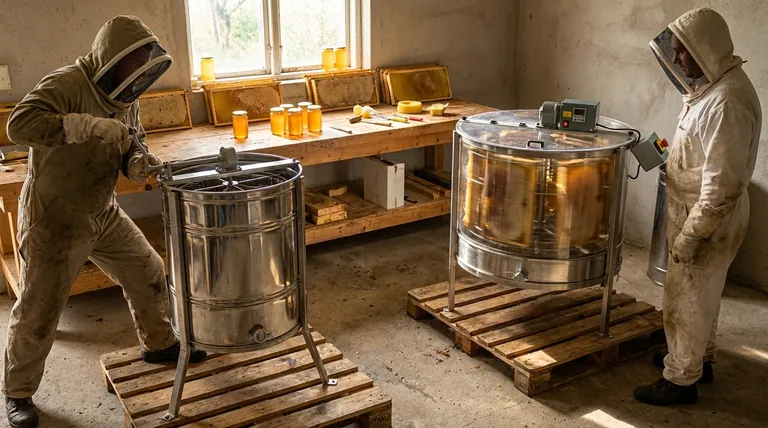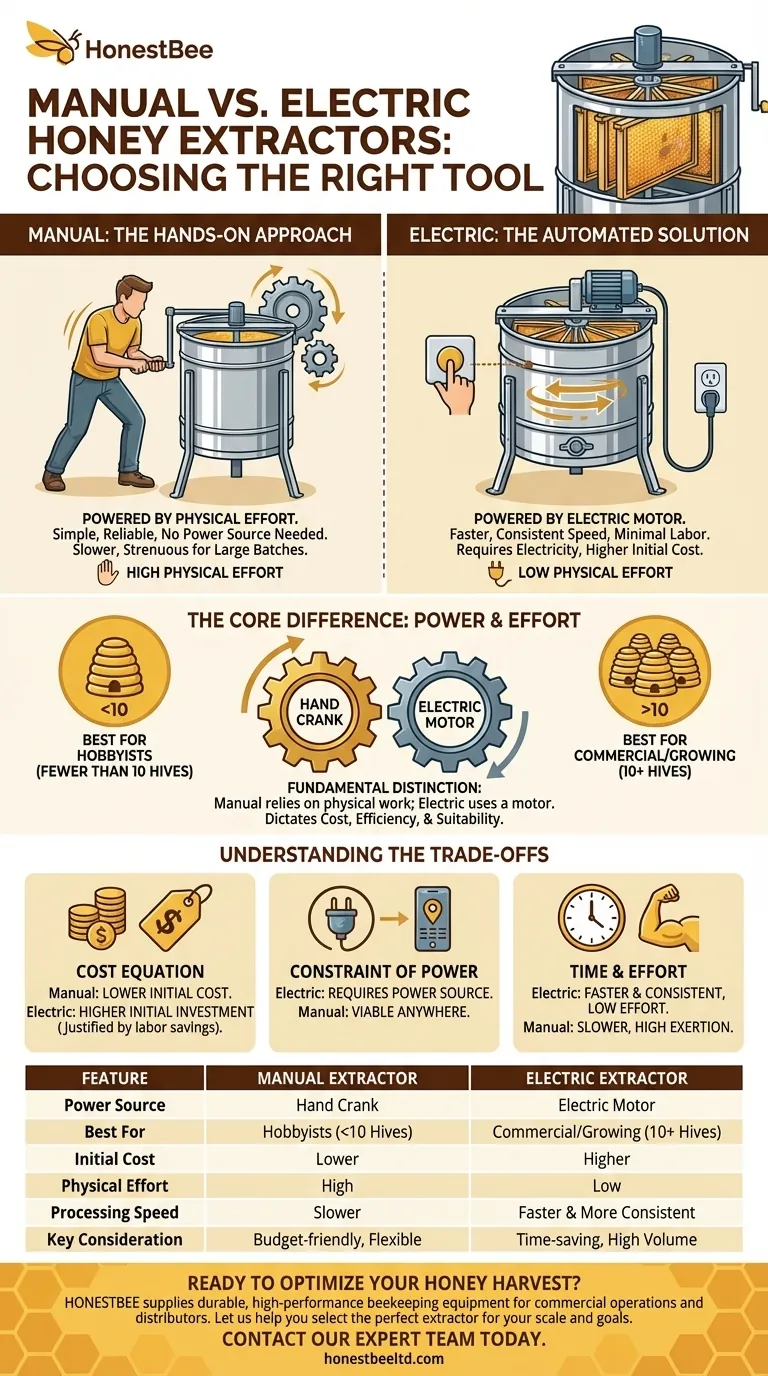At its core, the difference between a manual and an electric honey extractor lies in how the frames are spun to release the honey. Manual extractors rely on a hand crank that you operate physically, while electric extractors use a motor to do the work for you. This fundamental distinction in power source dictates their cost, efficiency, and suitability for different scales of beekeeping.
The decision between a manual and electric extractor is not about which is superior, but which is the right tool for your specific goals. Your choice should be determined entirely by the scale of your beekeeping operation, your budget, and the value you place on your time and labor.

The Core Difference: Power and Effort
The primary operational difference comes down to a trade-off between manual labor and automated convenience. Each approach serves a distinct purpose in the honey harvesting process.
Manual Extractors: The Hands-On Approach
Manual extractors are powered by physical effort. You turn a hand crank, which spins a geared mechanism that rotates the basket holding your honey frames.
The speed and duration of the spin are entirely under your control. This makes them simple, reliable, and independent of any external power source.
Electric Extractors: The Automated Solution
Electric extractors replace the hand crank with an electric motor. With the press of a button or the turn of a dial, the motor spins the frames for you.
These models are significantly faster and require minimal physical work. They provide a consistent speed, which can improve the efficiency of the extraction and reduce the effort needed to harvest large quantities of honey.
How Scale Dictates Your Choice
The number of hives you manage is the single most important factor in this decision. The tool that is perfect for a backyard hobbyist is inefficient for a commercial operation.
For the Hobbyist (< 10 Hives)
A manual extractor is generally the most practical and economical choice for a beekeeper with a small number of hives.
The lower volume of honey to be processed does not typically justify the higher cost of an electric model. The physical effort is manageable for a few hives, and the lower initial investment is a significant advantage.
For the Growing or Commercial Beekeeper
An electric extractor becomes essential as your hive count grows. For those with more than ten hives or with commercial aspirations, the time and labor saved are invaluable.
The ability to process large numbers of frames quickly and with minimal physical strain dramatically increases productivity. This efficiency makes harvesting from a large apiary a manageable task rather than a monumental chore.
Understanding the Trade-offs
Choosing an extractor involves balancing cost, convenience, and operational constraints. Being aware of the downsides of each option is critical for making an informed decision.
The Cost Equation: Initial Investment vs. Labor
Manual extractors are significantly cheaper upfront, making them highly accessible for beginners or those on a tight budget.
Electric extractors represent a larger initial investment. However, for larger operations, this higher cost is often justified by the massive reduction in time and paid labor required for the harvest.
The Constraint of Power
An obvious but critical point is that electric extractors require a power source. If your apiary is in a remote location without access to electricity, a manual extractor is your only viable option.
Physical Exertion and Time
Do not underestimate the physical demands of a manual extractor. Cranking for an extended period is a workout and can be strenuous. The process is also inherently slower, taking much more time per frame than an electric model.
Making the Right Choice for Your Apiary
To select the best extractor, align your choice with the primary goal of your beekeeping journey.
- If your primary focus is a small-scale hobby (fewer than 10 hives) and a minimal budget: A manual extractor offers the most cost-effective solution to get your honey from the comb to the jar.
- If your primary focus is efficiency, time-saving, or managing a growing operation (10+ hives): An electric extractor is a necessary investment that will dramatically improve your productivity and reduce physical labor.
Choosing the right extractor is an investment in your process, ensuring your honey harvest is as rewarding as the work you put into your hives.
Summary Table:
| Feature | Manual Extractor | Electric Extractor |
|---|---|---|
| Power Source | Hand Crank | Electric Motor |
| Best For | Hobbyists (< 10 Hives) | Commercial/Growing Apiaries (10+ Hives) |
| Initial Cost | Lower | Higher |
| Physical Effort | High (You provide the power) | Low (Motor does the work) |
| Processing Speed | Slower | Faster & More Consistent |
| Key Consideration | Budget-friendly, no power needed | Time-saving, essential for large harvests |
Ready to Optimize Your Honey Harvest?
Whether you're a hobbyist beekeeper or a commercial apiary, choosing the right equipment is crucial for efficiency and productivity. HONESTBEE supplies durable, high-performance beekeeping supplies and equipment to commercial apiaries and beekeeping equipment distributors through our wholesale-focused operations.
Let us help you select the perfect extractor for your scale and goals. Contact our expert team today to discuss your needs and explore our wholesale catalog!
Visual Guide

Related Products
- HONESTBEE 72 Frame Industrial Electric Honey Extractor for Beekeeping
- HONESTBEE 6 Frame Self Reversing Electric Honey Extractor for Beekeeping
- Professional 4 Frame Self Reversing Electric Honey Extractor for Beekeeping
- HONESTBEE 3-Frame Manual Acrylic Honey Extractor
- 2 Frame Stainless Steel Manual Honey Spinner Extractor for Beekeeping
People Also Ask
- What should a beekeeper do after extracting honey from supers? A Guide to Harvest Management
- Why do beekeepers have to lift a lot of weight at the end of a growing season? The Reward of a Heavy Harvest
- Can a manual extractor be upgraded to an electric one? Save Labor & Boost Efficiency
- How do automatic honey extractors function? Achieve High-Efficiency Honey Harvesting
- Why is preserving honeycomb integrity important, and how do automated extractors help? Boost Hive Health & Honey Yields



















